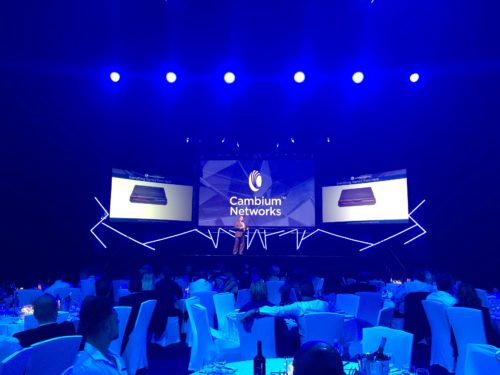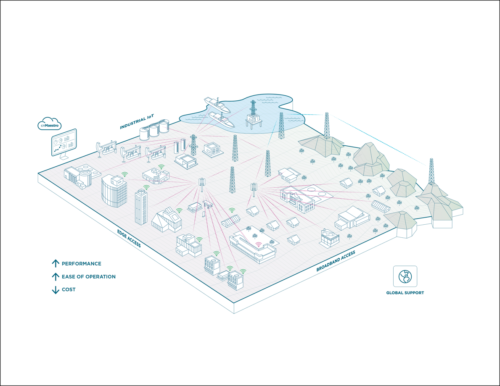I have recently been on the road visiting with Cambium Networks ConnectedPartners and network operators in Johannesburg, South Africa and Moscow, Russia and experienced the Wireless Fabric of connectivity in action.
In Johannesburg, the Jacaranda trees were in full bloom the week we launched the new ePMP™ 3000 wireless broadband solutions at Vodacom World in Midrand. With over 150 attendees from across South Africa in attendance; Sakid Ahmed, VP of ePMP, and Mark Goosen, Regional Sales Director Sub-Saharan Africa, joined me in introducing the latest ePMP technology. The launch presentation, which includes a retrospective on both the evolution of ePMP and PMP 450, is now available on Facebook. I also had the opportunity to visit with our two ConnectedPartner Distributors, Duxbury Networking and MirRO, and many of our customers in the region over the course of the week. The key themes that emerged include:
across South Africa in attendance; Sakid Ahmed, VP of ePMP, and Mark Goosen, Regional Sales Director Sub-Saharan Africa, joined me in introducing the latest ePMP technology. The launch presentation, which includes a retrospective on both the evolution of ePMP and PMP 450, is now available on Facebook. I also had the opportunity to visit with our two ConnectedPartner Distributors, Duxbury Networking and MirRO, and many of our customers in the region over the course of the week. The key themes that emerged include:
- Congestion of 5 GHz spectrum
- Reliable coverage modeling (recall those Jacaranda trees…)
- Emergence of managed service provider models for the provisioning of Wi-Fi services
- Accelerating small medium enterprise channel business around cnPilot™ (Wi-Fi) and cnMatrix™ (intelligent edge switching).
In Moscow, my travels rapidly took me from early Summer to early Winter: from 26oC in Johannesburg to -5oC in Gorky Park where the final leaves are dropping from the hardwoods. This was my first trip to Russia, and certainly will not be my last, and was enlightening. As in South Africa, I had the opportunity to spend time with both ConnectedPartners and network operators. One of the distinctions of Moscow is the deployment of Wi-Fi access networks in public venues including parks, shopping districts, historic districts, and the Metra. Literally everywhere I walked I had access to Wi-Fi. There is also a healthy appetite to extend fixed broadband access to residential addresses in rural markets – to connect the unconnected. The outdoor Wi-Fi networks in Moscow are largely backhauled with PMP distribution networks (lots of ePMP Force 180s and even some legacy PMP 100 sightings). In addition, an incredibly competitive broadband market has forced ARPU (Average Revenue per User) down to questionably sustainable levels (e.g., the equivalent of ≈ $8/month for high speed residential access).
Congestion in the 5 GHz band is not unique to Moscow or Johannesburg – it is a worldwide reality. Advancements in dynamic filtering, beam steer smart antennas, up link and down link MU-MIMO, and GPS synchronization all contribute to improved performance and Cambium Networks’ investment in research and development will continue to address the challenge.
Efforts to open up adjacent spectrum, like the FCC’s efforts at 6 GHz (NPR 18-147) in the US, are welcome. However, bringing economically and technically compelling fixed broadband access solutions utilizing 60 GHz and 24 – 29 GHz will enable significantly higher data rates and reduce industry dependence on 5 GHz. Cambium Networks is devoting significant resources to both and looking forward to initial market introductions in 2019.
Historically, the use of 10 meter clutter data in coverage modelling tools was the gold standard. The challenge being acquisition of current data that reflected tree growth and humankind’s propensity to build, and the associated cost of that data. Cambium Networks has recently advanced utilization of LiDAR as an alternative tool with great success. The clarity of topography coupled with enhancements on the predictive algorithms has resulted in far more accurate coverage modeling. There is work to be done in applying LiDAR’s information, and of course collection of the LiDAR data itself, but substantive progress has been made and expected to continue in 2019.
I was encouraged in both Russia and South Africa to see the recognition and adoption of cnPilot, Cambium Networks Wi-Fi access portfolio. It is evident that our outdoor portfolio (cnPilot e500, e501 and e502) are considered best in class and being enhanced further with the introduction of the e700 802.11ac Wave 2 platform. The combination of cnPilot e410 and e600 is the right combination for indoor enterprise depending on user density. The hospitality industry’s awareness of e430, the wall plate solution, is growing but tremendous opportunity as the industry seeks to improve guest experiences and meet their wireless data consumption demands. Most encouraging on this front is adoption of the cnMaestro™ management system by managed service providers (MSP) to monitor and control end-to-end networks in a multi-tenancy model.
The opportunity to hear directly from partners and customers is invaluable – the good, the bad and the ugly all contribute to bringing compelling products to market the address challenges and opportunities; and the building of a business organization to effectively support both. I am looking forward to an upcoming trip to India to receive similar guidance!